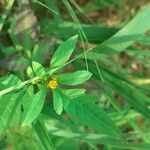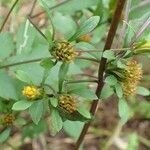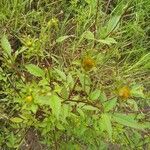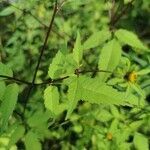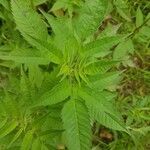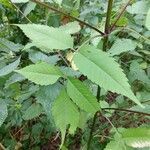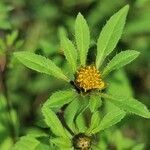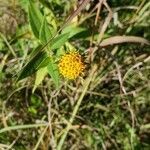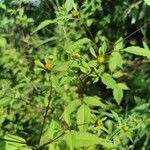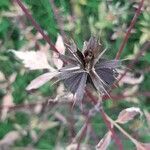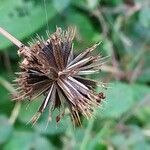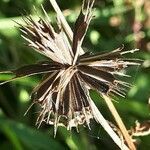Annuals, (10–)20–60(–180) cm. Leaves: petioles 10–40(–60) mm; blades deltate to lance-ovate overall, 30–80(–150+) × 20–60(–100+) mm, 3(–5)-foliolate, leaflets petiolulate, lanceolate to lance-ovate, (15–)35–60(–120) × (5–)10–20(–30) mm, bases cuneate, margins dentate to serrate, sometimes ciliate, apices acuminate to attenuate, faces glabrous or hirtellous. Heads usually borne singly, sometimes in 2s or 3s or in open, corymbiform arrays. Peduncles 10–40(–80+) mm. Calyculi of (5–)8(–10) ascending to spreading, spatulate or oblanceolate to linear, sometimes ± foliaceous bractlets or bracts 5–20(–60) mm, margins usually ciliate, abaxial faces glabrous or hirtellous. Involucres campanulate to hemispheric or broader, 6–9 × 7–12 mm. Phyllaries 6–12, oblong or ovate to lance-ovate, 5–9 mm. Ray florets 0 or 1–3+; laminae golden yellow, 2–3.5 mm. Disc florets 20–60(–120+); corollas ± orange, 2.5–3+ mm. Cypselae blackish to brown or stramineous, ± obcompressed, obovate to cuneate, outer 5–7 mm, inner 7–10 mm, margins antrorsely or retrorsely barbed, apices ± truncate to concave, faces usually 1-nerved, sometimes tuberculate, glabrous or sparsely hirtellous; pappi of 2 ± erect to spreading, antrorsely or retrorsely barbed awns 2–5 mm. 2n = 24, 48, 72.
Erect, glabrous or almost glabrous annual, 20-200 cm tall. Stems angled, branched above to form infl., and sometimes from base. Lvs petiolate, 1-pinnate, with 1-2 pairs of leaflets and a slightly larger terminal leaflet; leaflets sessile or shortly petiolulate, narrow-ovate to lanceolate, coarsely or unevenly serrate, acuminate, (1)-2-13 cm long. Upper cauline lvs becoming smaller, shortly petiolate, and often simple and not lobed or 3-lobed. Capitula 10-20 mm diam. Outer involucral bracts 4-9, foliaceous, usually ciliate at least at base, sometimes glabrous, linear to narrowly oblong-obovate, (10)-15-30 mm long; inner bracts many, membranous, triangular to subulate, 6-10 mm long, with dark lined centre and pale margins. Receptacular scales similar to inner bracts but narrower. Florets usually all ☿, tubular, yellow-orange, rarely a few orange ray florets present. Achenes flattened, ovate-cuneate with 1 slender rib on each face, dark brown, ciliate, and otherwise glabrous to sparsely hairy, 6-10 mm long; awns 2, 2.5-4.5 mm long.
Annual, generally glabrous or nearly so, 2–12 dm; lvs on petioles 1–6 cm, pinnately compound, with 3–5 lanceolate, acuminate, serrate lfls to 10 × 3 cm, sometimes sparsely short-hairy beneath, at least the terminal one slender-petiolulate; heads campanulate to hemispheric, or narrower in depauperate plants, discoid or nearly so, the disk to 1 cm wide in fl; outer invol bracts 5–10, typically 8, green and ± leafy, usually conspicuously surpassing the orange disk, evidently ciliate on the margins, at least toward the base; anthers exserted; achenes flat, narrowly cuneate, strongly 1-nerved on each face, commonly dark brown or blackish, subglabrous or appressed-hairy, 5–10 mm; pappus of 2 retrorsely (seldom antrorsely) barbed awns; 2n=24, 36, 48, 72. Waste places, especially in wet soil; Nf. and N.S. to Wash., s. to Ga., La., and Calif. June–Oct.
A herb. It grows each year from seed. It grows 20-120 cm tall. The leaves are oval to sword shaped and 3-8 cm long by 2-6 cm wide. There are 3 (or 5) leaflets. These are 4-6 cm long by 1-2 cm wide. There are teeth along the edge.
